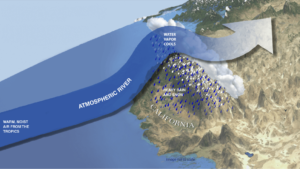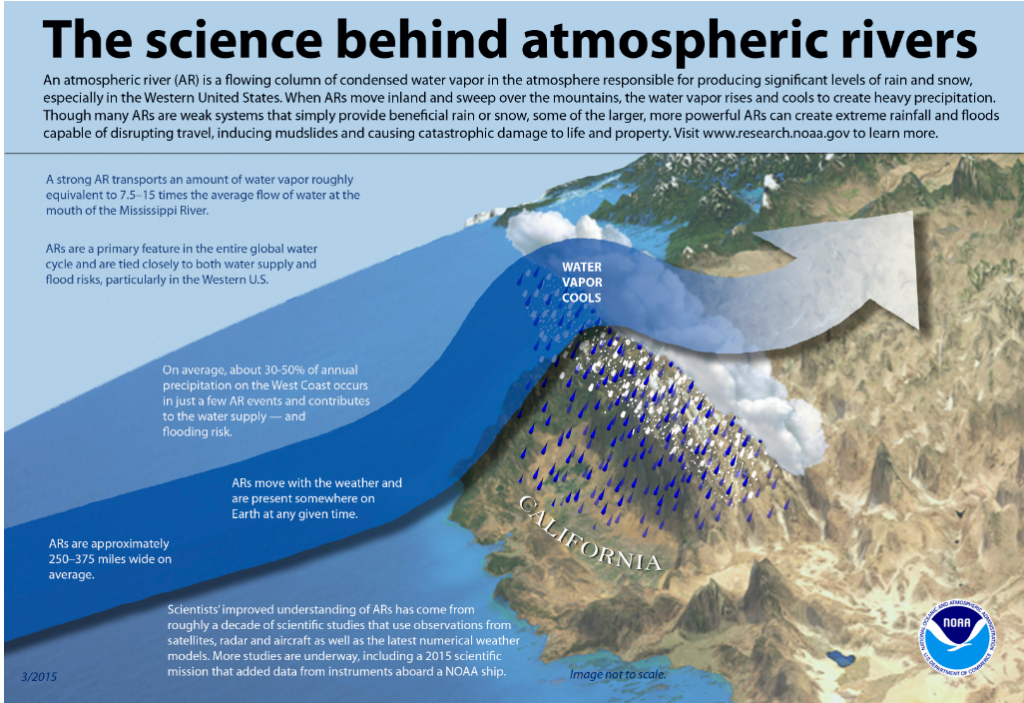Physical Address
23,24,25 & 26, 2nd Floor, Software Technology Park India, Opp: Garware Stadium,MIDC, Chikalthana, Aurangabad, Maharashtra – 431001 India
Physical Address
23,24,25 & 26, 2nd Floor, Software Technology Park India, Opp: Garware Stadium,MIDC, Chikalthana, Aurangabad, Maharashtra – 431001 India

By Suja Mary James
India, the land of biodiversity, is under severe climatic stress. From torrential rain to scorching heat, the population is at extreme risk. The impact of climate change on ‘atmospheric rivers’ has been blamed as one of the primary reasons for the recent increase in extreme weather events in the region in the past few years. For example, studies have found that the recent disastrous floods in India have been brought on by atmospheric rivers, notably those that wreaked havoc in the state of Kerala in 2018 and Uttarakhand in 2013.
In the lower atmosphere, atmospheric rivers (ARs) are confined areas that transmit significant volumes of water vapour over great distances. Researchers Zhu and Newell (1998) initially used the phrase “atmospheric rivers” after seeing that the majority of water vapour in the atmosphere was being carried in very small regions that were only 400 km wide.
What is an Atmospheric river?
“Atmospheric rivers (AR) are relatively long, narrow regions in the atmosphere – like rivers in the sky – that transport most of the water vapour outside of the tropics” -defined by NOAA (National Oceanic and Atmospheric Administration). The Earth typically contains four to five active ARs at any given moment. They can be more than 1,000 miles long and between 250 and 375 miles wide.
The climate of the planet is significantly influenced by atmospheric rivers. They are in charge of 90% of the moisture transfer from the tropics to the poles. As a result, AR plays a substantial role in cloud formation and have a major impact on air temperatures, sea ice, and other climate-related variables. Certain researchers claim that AR are responsible for more than 50% of the precipitation in certain coastal regions of North America, France, Spain, Portugal, the United Kingdom, South America, Southeast Asia, and New Zealand. However, because of the enormous volumes of precipitation they unleash, atmospheric rivers can also lead to serious floods.
Although there are many different types and sizes of AR, extreme rainfall events and floods are only caused by the ones with the highest concentrations of water vapour and the strongest winds. These extreme events have the potential to obstruct movement, trigger mudslides, and harm people and property. Not all atmospheric rivers cause disruption. Many are weak and give useful rain or high-elevation snow that is essential to the water supply. Based on NOAA’s Earth System Research Laboratory (ESRL), strong ARs can transport water vapour up to 15 times the typical flow of liquid water at the mouth of the Mississippi River.

Source: Manteca Bulletin
A well-known illustration of this phenomenon is the “Pineapple Express,” a powerful atmospheric river that has the power to transport moisture from the tropics near Hawaii to the U.S. West Coast. In the Western United States and Canada, the Pineapple Express can bring about significant snowfall and rain. It can produce up to 5 inches of rain in a single day in California.
Typically, atmospheric rivers begin over tropical areas. Ocean water evaporation and atmospheric uplift are caused by the region’s warm temperatures. The water vapour is aided in its ascent through the atmosphere by strong winds. The water vapour rises further into the atmosphere as atmospheric rivers pass over land. It then cools into water droplets, which eventually fall as precipitation.
Formation of Atmospheric rivers
The formation of AR remains a debatable topic as there are many explanations for how the filament of water forms. According to Dacre et. al,(2015), AR is formed as the cold front approaches the warm front, it picks up water vapour from the warm sector. This leads to the base of the warm conveyor belt airflow forming a narrow region of high water vapour content ahead of the cold front. As a result, high water vapour content filaments are produced by water vapour in the cyclone’s warm sector rather than by long-distance transfer of water vapour from the subtropics. Water vapour lost during precipitation is replaced by an ongoing cycle of evaporation and moisture convergence inside the cyclone.

Source: NOAA
The term “atmospheric river” implies that moist air from the subtropics is continuously fed into the centre of a cyclone, but in reality, these filaments are the result of water vapour exported from the cyclone, and they thus represent the footprints that cyclones leave behind as they move poleward from the subtropics.
The main characteristics or defining features of Atmospheric Rivers are (Rao et.al, 2016),
1) Integrated Water Vapour concentrations (IWV) such that if all the water vapour in the atmospheric column were to be condensed into liquid water the result would be 2 or more cm thick water as precipitation.
2) Wind speeds of greater than 12.5 meters per second in the lowest 2 km.
3) A shape that is long and narrow, no more than 400 to 500 Km wide and extending for thousands of Kilometers sometimes across entire ocean basins.
The importance of atmospheric rivers in both the abrupt shift in weather and the global mid-latitude water cycle has been highlighted in many research papers over the past ten years. The pattern of airflow in the northern hemisphere of the world is disrupted by human-induced climate change. In regions where these features confront mountains, the AR variations in the course are the primary sources of the most intense precipitation and flooding. They also play a significant role in the availability of snow and water in these areas.
Climate change and atmospheric rivers
The impact of climate change on precipitation is arguably one of the best-understood facets of the phenomenon. Evaporation rates rise as the temperature rises, converting more liquid water molecules in the air to vapour. In fact, with every 1 degree Celsius (1.8 degrees Fahrenheit) rise in temperature, the atmosphere can retain around 7% more water. The intensity of rain events rises because of the ability of this moisture-rich air to produce higher amounts of precipitation all at once.
By the end of this century, atmospheric rivers are predicted to become more intense globally while decreasing in number, according to a new NASA-led study. According to the latest study, atmospheric rivers will be much broader and longer than they are now, which will cause them to occur more frequently in the impacted areas. According to the study’s lead author, Duane Waliser of NASA’s Jet Propulsion Laboratory in Pasadena, California, “the results project that there will be about 10% fewer atmospheric rivers globally by the end of the 21st century in a scenario where greenhouse gas emissions continue at the current rate.” The frequency of atmospheric river conditions, such as heavy rain and high winds, will actually rise globally by around 50% as a result of the findings, which forecast that the atmospheric rivers will be, on average, roughly 25% broader and longer. The findings also indicate that the most powerful atmospheric river storms are expected to occur more frequently—nearly twice as frequently.
According to a recent study, climate change boosted the quantity of rainfall from two air rivers in February 2017, which significantly damaged the second-largest dam in California, Oroville Dam, and forced 188,000 people to evacuate. Due to warming caused by burning fossil fuels, the atmospheric rivers produced between 11 and 15 per cent more rain. The researchers showed that rainfall amounts would have been 20 to 60 per cent higher if the same events had occurred in a world that was even warmer than it is now, as is predicted to be the case by the end of the twenty-first century. In other experiments simulating future atmospheric rivers, it is shown that rainfall will surely rise in a warmer world, by up to an additional 40%.
The locations that atmospheric rivers affect may be significantly impacted. It is possible for flooding, mudslides, and landslides to occur as a result of the intense rainfall brought on by these systems, which can result in fatalities and property damage. Additionally, by overburdening reservoirs and other water infrastructure, atmospheric rivers can compromise water availability. These systems occasionally have the ability to produce drought-like conditions by removing rainfall from regions that depend on it for agriculture or other businesses. Regions that are already vulnerable to these kinds of events as well as infrastructure that is not built to withstand such severe precipitation could be significantly impacted by this.
Effect of AR on India
Almost the whole Indo-Gangetic plains (IGP) are covered in a thick haze and fog throughout the winter months of December and January every year. However, recent years have seen a reported abrupt increase in the spatiotemporal extent of fog and haze. This has been linked to rising pollution levels and water vapour, but it’s unclear why the latter has increased. Verma et.al (2022) notice atmospheric rivers (AR), a phenomenon that causes moisture intrusion from the Arabian Sea to landfall intermittently throughout the 12–25° N corridor of India’s west coast during winter. It is believed that the movement of moist-laden winds from ARs onto the Himalayan Mountains is what causes the precipitation, which accounts for the observed increase in the extreme flow of the western Himalayan Rivers in winter. They also the conclusion that these ARs, which are coupled with pollutants, are probably responsible for the declining snow albedo in the Hindukush-Karakoram-Himalayan mountain range.
Extremely heavy and intense precipitation over the higher reaches of northern India is due to the eastward-moving cyclonic circulations in the northern latitudes of India in conjunction with the atmospheric rivers drawing water vapour from the lower latitudes. When atmospheric rivers cross mountainous terrain, such as the Himalayan ranges in North India, they produce a lot of precipitation. This was the core reason for 2010, 2011 and 2013 floods in Jammu and Kashmir, Himachal Pradesh and Uttarakhand.
Atmospheric rivers hold both positive and negative impacts on the Earth’s climate. Atmospheric rivers are anticipated to become even more crucial as climate change continues to affect weather patterns all across the planet. These moisture rivers can provide drought-stricken areas with much-needed rainfall, but they can also trigger catastrophic floods in locations that receive too much rain. To more accurately predict and be ready for extreme weather occurrences, it is crucial to track and research atmospheric rivers in India. Atmospheric rivers and other extreme weather events can be lessened with the use of mitigation strategies such as better drainage systems, the construction of flood-resistant infrastructure, and the creation of early warning systems.
Source:
https://www.weather.gov/media/ajk/brochures/Alaska%20Atmospheric%20River.pdf
https://www.energy.gov/science/doe-explainsatmospheric-rivers
https://www.washingtonpost.com/weather/2023/01/12/climate-change-atmospheric-rivers-rain/
https://climate.nasa.gov/news/2740/climate-change-may-lead-to-bigger-atmospheric-rivers/
https://www.nature.com/articles/s41598-022-09206-9
https://ui.adsabs.harvard.edu/abs/2018AGUFM.A11N2473D/abstract
https://www.science.org/doi/full/10.1126/sciadv.aba1323
https://agupubs.onlinelibrary.wiley.com/doi/full/10.1029/2021EF002537